Benefits of Feeding a Kibble Diet
When thinking about a raw meat versus a dry food diet, there are a few things to think about.
Did you know that a premium kibble diet can:
- save you time and money;
- provide a consistent and nutritionally balanced diet; and
- ensure that your greyhound’s feed is free of contaminants and infectious agents.
Traditionally, most trainers feed a mix of raw meat and kibble and/or bread to their greyhounds. However, mounting evidence suggests that the risks of including raw meat in a greyhound’s diet may outweigh the benefits. Raw meat comes with risks of bacterial, parasite and chemical contamination. Chemical contaminants include veterinary drugs, which may be prohibited substances under the Greyhounds Australasia Rules. Nutritional imbalance and inconsistency are also issues with using home-made diets, as accurately calculating the amount of protein, fat and carbohydrate can be very challenging.

Feeding a diet of good quality kibble eliminates many of the risks associated with the traditional racing greyhound diet and is safer, easier and more nutritionally balanced. In many cases, good quality kibble is cheaper than home-made diets and provides your greyhound with better nutrition enabling best possible racing performance, growth and injury recovery.
Raw meat can be contaminated with a variety of nasty things – bacteria such as Salmonella, Campylobacter, E. coli, Listeria or parasites. Bacterial and/or parasitic contamination often occurs either at or after slaughter, particularly if meat is:
- stored inappropriately (e.g. poorly refrigerated either prior to or after purchase);
- hygiene practices are inadequate (e.g. fridges or meal preparation areas are not cleaned and regularly disinfected); or
- fed beyond its use-by date.
While trainers may maintain careful hygiene practices in their kennels, correct storage and handling of raw meat cannot be guaranteed throughout all stages of the supply chain. While many trainers are aware of the risks of bacterial contamination in raw meat, the risk of transmitting parasitic disease is less well known. A recent study investigating the prevalence of parasitic infection within Australian racing greyhound populations detected several parasites which are contracted through consumption of raw meat1.
Raw meat diets can also contain chemical contaminants. Most trainers are familiar with the types of substances prohibited under the racing rules. While most trainers are extremely careful of where they source their meat, it is not always possible to control everything and contamination with prohibited substances does occur.
The main goal of any diet is to provide an optimal balance of carbohydrates, fats and protein with sufficient vitamins and minerals. Greyhounds have a higher energy demand than other dog breeds which means they need more calories per kilogram of body weight. Unlike other animals, greyhounds use fats as their primary source of energy, followed by carbohydrates. Protein is important for growth and repair and regeneration of muscle. Different studies have investigated the ideal balance of protein, fat and carbohydrates in greyhound diets to optimise racing performance. These studies suggest that a diet providing 20-45% of energy from protein and 40-50% of energy from fat is the most efficient diet for the racing greyhound.2, 3, 4
It can be difficult to estimate the protein, fat, vitamin, and mineral content in raw meat diets. While estimates for fat, protein and vitamin contents are provided for human grade meats on supermarket labels and standard reference charts, most of the meat sources fed to greyhounds are not human grade bought from supermarkets. Their fat, protein and vitamin content vary from batch to batch, and as a result, the amount of protein and fat is not consistent.
Vitamins and minerals are important to maintaining strong bones, a healthy immune system, healthy skin and nervous system, and supporting energy metabolism. It can be difficult to ensure the correct balance of the minerals, including calcium and phosphorus in a raw meat diet. These are critical throughout a greyhound’s life to maintain skeletal strength and muscle function. Did you know calcium is a key component in muscle contraction (movement)? If muscles do not have sufficient calcium they cannot move as fast or as well as they should. A greyhound with insufficient calcium in their diet will not be a successful racing dog.
Premium kibble diets on the other hand are formulated to provide balanced levels of essential amino acids (the building blocks for protein), fats, carbohydrate, vitamins and minerals. The nutritional information available on premium dry food packaging allows for a high level of consistency and accuracy when feeding.
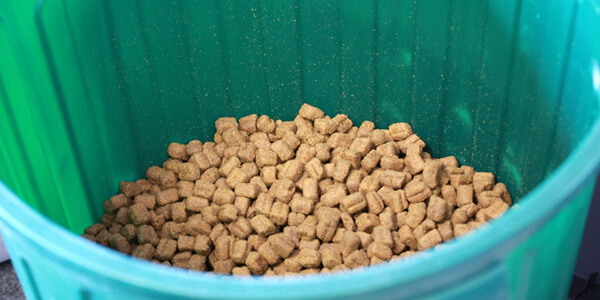
The cost-benefits of a premium kibble diet can be measured in terms of both time and money. Given most racing greyhound diets consist of meat, kibble and sometimes bread, eggs, milk, and various supplements, the costs of purchasing raw meat, supplements, refrigerated storage, added to the time to prepare of each greyhound’s feed means that many home-made racing diets are expensive! In contrast, a premium kibble is nutritionally balanced and, in most cases, can simply be weighed out and given to your greyhounds without the need for any mixing or addition of supplements. The Greyhound Adoption Program recently undertook a cost analysis and found a premium kibble saved them $10 a month per dog compared with a lower quality kibble and pet mince diet. In addition, the time saved by a premium kibble only diet can be invested into other activities like checking or exercising your greyhounds.
In conclusion, participants should consider gradually switching to a premium kibble; it can save money and time while giving you peace of mind that your greyhound is being fed a nutritionally balanced and contaminant free diet.
GRV recommends that you consult with your veterinarian regarding the most suitable kibble diet for your greyhounds and the best way to transition your greyhounds to a kibble only diet.
For more information please here are some useful references:
- Ash A, Paul A, Lymbery A (2016). Investigating gastrointestinal parasites within the Australian Racing Greyhound: Baseline prevalences and considerations for drug efficacy and parasite control methods. School of Veterinary and Life Sciences, Murdoch University, Perth, WA.
- Ferguson, R (2019). Nutrition for Success – The Racing Greyhound. [PowerPoint Presentation].
- Hill RC, Bloomberg MS, Legrand-Defretin V, et al. (2000). Maintenance energy requirements and the effect of diet on performance of racing greyhounds. Am J Vet Res, 61:1566-1573.
- Hill RC, Lewis DD, Scott KC, et al. (2001). Effect of increased dietary protein and decreased dietary carbohydrate on performance and body composition in racing Greyhounds. Am J Vet Res, 62: 440-447.
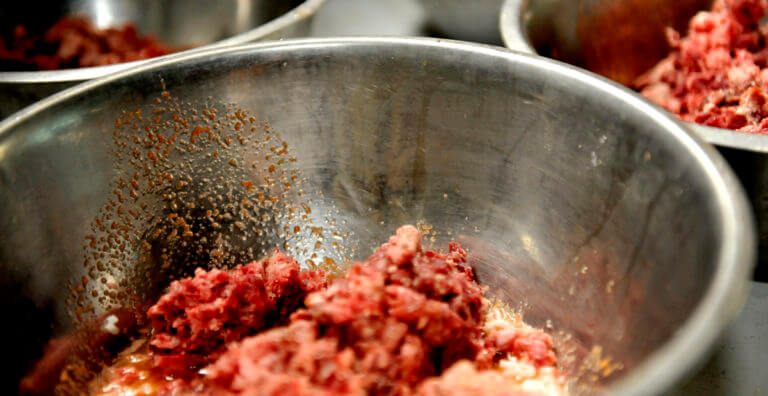
Great care and vigilance must be taken in the feeding and training of greyhounds to ensure they are free of prohibited substances, including that any prohibited substances are not administered ‘accidentally’. It is the responsibility of participants to carefully consider the use of any food to make sure that all greyhounds are free of prohibited substances. Evidence at past RADB hearings has suggested that the potential for feeding contaminated meat is a real concern and may occur when livestock are treated with medication shortly before death. These animals often end up at the knackery, where the meat is processed as ‘unfit for human consumption’ and is sold on as pet food. Offal such as liver or kidneys may have increased concentrations of drugs and feeding carries increased risk and should be avoided.
GRV does not support the feeding of ‘unfit for human consumption meat’ and participants who choose to do so take the risk that prohibited substances may be inadvertently administered.
Participants could consider feeding ‘cleaner’ meat (i.e. ‘human consumption grade’, chicken or kangaroo meat) or no meat (using a commercial complete dry food).
It is understood that some participants choose to feed knackery meat (unfit for human consumption), other than a minimum of 72 hours prior to racing. GRV warns, however that some substances (such as anaesthetic agents) are permanently banned prohibited substances and therefore must never be present in a greyhound, including during out-of-competition testing.
GRV does not support the feeding of bread or other baked goods containing poppy seeds, as they may result in a positive morphine swab. Morphine is a permanently banned prohibited substance and therefore must never be present in greyhounds (except where therapeutic exemptions exist as per GAR 79A(6).
The feeding of substances containing chocolate, liquids containing tea and/or coffee, various supplements and products from ‘health food shops’ should also be very carefully considered prior to choosing to administer them to your greyhound.
There are many different brands and types of supplement on the market, and you only have to look through any of the greyhound papers or magazines to see advertisements for the latest product designed to help your dog become a winner. Some of these supplements are specifically formulated for greyhounds in work while others are designed for dogs in general. There are multi-vitamin and mineral supplements, electrolyte supplements and supplements containing essential fatty acids and amino acids.
The feeding of substances containing chocolate, liquids containing tea and/or coffee, various supplements and products from ‘health food shops’ should also be very carefully considered prior to choosing to administer them to your greyhound.
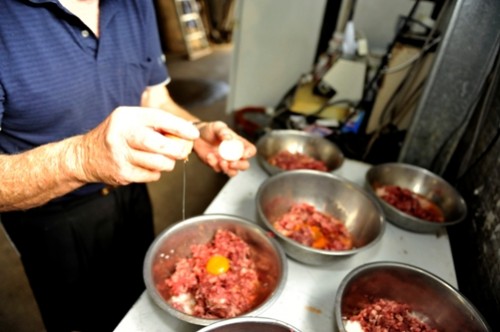
The reason for using a supplement is to overcome deficiencies within the diet that may occur due to the way food is processed, preserved and prepared. The greyhound’s body requires vitamins, minerals, trace elements and electrolytes to function – not enough, and the body cannot function optimally, too much and the body simply sends the excess out as waste.
The amount required of each nutrient can vary depending on the dog’s age, work load, health status, stress levels and physical condition. Young or growing dogs may need different levels of certain minerals to a dog that is spelling. A brood bitch with pups will need different things to a dog in light work. So the decision to supplement the greyhound’s diet depends on its needs.
Feeding your dog good quality food is the most important step to getting the balance right. If you use commercial, prepared foods, someone else does the hard work for you, and as long as the food is fresh and stored correctly, it should cover most of the dog’s requirements. On the other hand, if you choose to prepare the food yourself, you will need to know exactly what’s in the food to make sure it meets the greyhounds needs. Simply putting some meat, rice, vegies and bread into a bowl is not necessarily a complete or balanced diet.
There are so many supplements out there it is very difficult to know what you really need. It’s a great idea to discuss the ration you make with your greyhound vet. They will have a good idea of what is likely to be missing, and can advise on a suitable supplement.
If you are thinking of adding a supplement because your greyhound is not performing to the level that you expect given its training history, a thorough check up at the vets including a blood profile should be considered prior to trying to guess what is wrong. This may save you money in the long run.
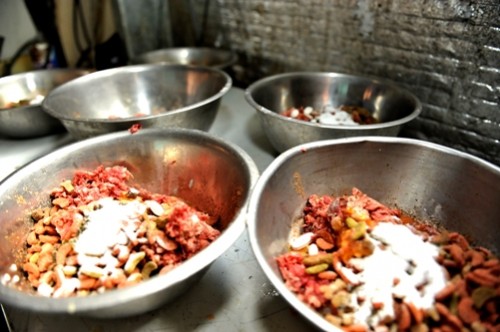
It is very important that you follow the instructions on the supplement label. These will tell you how much of the product to use and how often. It will also have storage instructions that need to be followed to ensure the product does not spoil or lose its potency.
Most supplements should be added to the diet just prior to feeding so that they do not interact with other food components, and do not lose their potency.
You need to be very careful about what ingredients are in each supplement, as some contain products that can lead to a positive swab.
If you are not sure what an ingredient is or what it is for, it would be wise to discuss your choice of supplement with your greyhound veterinarian as they will be able to tell you whether or not the ingredient poses a concern.
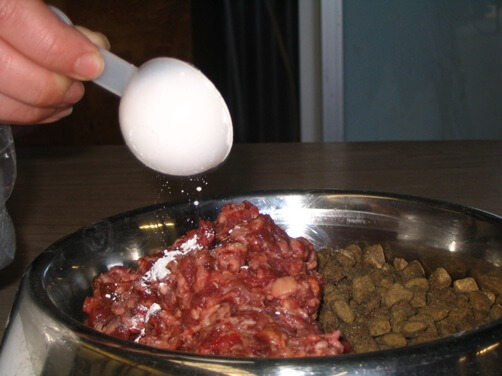
4-D meat is used by the racing industry to reduce costs
At racetracks across the United States, dogs are fed a diet based on “4-D” meat. This is meat derived from dying, diseased, disabled and dead livestock that has been deemed unfit for human consumption. The United States Department of Agriculture requires that charcoal be added to this meat to discourage human use.
Meat fed to racing greyhounds is marked “inedible.” (Florida Dept. of Agriculture and Consumer Services)
4-D or knackery meat is considered a cheap way to feed greyhounds. (Pima County Animal Care Center)
4-D meat is derived from dying, diseased, disabled or dead animals. (Pima County Animal Care Center)
According to an industry handbook, 4-D meat is used at commercial dog tracks because “it is the most economically feasible for the Greyhound industry at this time.”
As a result of eating 4-D meat dogs can be exposed to pathogenic microorganisms, including Salmonella, Campylobacter jejuni, and Escherichia coli. In addition, the use of 4-D meat can lead to false drug positives due to drug residues that dogs ingest and pass into the urine. According to the U.S. Food and Drug Administration, raw 4-D meat “may present a potential health hazard to the animals that consume it and to the people who handle it.” In 2017, one dog died and 72 fell ill at the Sanford Orlando Kennel Club in Florida from a suspected case of “bad meat.” Investigators found that the carpet of the greyhound who died was saturated in vomit and feces. In 2014, two dogs died and close to 100 fell ill at Daytona Beach Kennel Club, also due to “bad meat.”
According to the Texas Greyhound Association, dogs who arent racing on any given day are usually fed in late morning. The standard greyhound diet is high in protein from raw meat, which has greater nutrient value than cooked meat, the TGA maintains. In Texas, diets also include commercial kibble, pasta, vitamins and minerals. Before races, competitors get a light-protein meal and their full meal only after theyve cooled down. On race days, the GRAA suggests administering “a hit of glucose” an hour before starting time. Carbohydrates, including wheat, brown rice and oats, are another component of the racing greyhound diet. Carbs are transformed into glucose by their bodies, but though the resulting elevation in blood sugar promotes speed, it doesnt last long, says the GRAA.
“Meat is not a balanced food and is deficient in essential vitamins and minerals,” wrote Richard C. Hill of the College of Veterinary Medicine at the University of Florida in Gainesville. In his survey of peer-reviewed literature on the nutritional needs of canine athletes, published in The Journal of Nutrition in 1998, Hill observed that the lack of information about the special nutritional needs of racing greyhounds has encouraged most trainers to come up with their own recipes, which are heavily based on raw meat. Many of the food-borne pathogens that cause food poisoning in people who eat undercooked meat or unpasteurized food can also poison or kill dogs, including salmonella, shigella, E. coli, campylobacter, listeria, clostridium perfringens, mycobacterium bovis and staphylococcus, Hill wrote.
A greyhound running at full tilt is poetry in motion. But to keep energy levels as high as they need to be in order to win races, these canine athletes require diets high in protein and fat. For peak performance, the Greyhound Racing Association of America recommends feeding dogs a combination of raw meat, carbohydrates and nutritional supplements. However, critics contend that uncooked animal protein puts dogs at risk of sickness or death from deadly food-borne pathogens.
“Racing greyhounds simply do not perform as well on a commercial diet as on one partially composed of raw meat,” the GRAA maintains. Cooking might kill E. coli, but it also diminishes the nutritional value of the meat. When correctly handled, “raw meat has proven safe and effective,” and racing greyhounds seldom die from food-borne diseases. Raw beef, lamb, mutton or chicken are the primary ingredients in racing greyhounds diets, which may also include raw eggs and milk. Together, these protein sources provide the dogs with the amino acids, vitamins and minerals necessary for health and peak racing performance. Within the United States, “there are as many variations in feeding methods as there are trainers,” notes the GRAA. Feeding preferences also differ widely between the U.S. and other countries that have greyhound racing, the association says.
In August 2012, the American Veterinary Medical Associations House of Delegates approved its current policy on raw or undercooked animal protein in dog and cat diets. The position it takes, shared by the Centers for Disease Prevention and Control, the Food and Drug Administration and the American College of Veterinary Nutritionists, is that dogs should not be fed any animal proteins, including eggs and milk that havent first been cooked or pasteurized, to reduce the risk of transmitting food-borne pathogens. To support its contention that raw meat exposes dogs to unacceptable levels of risk, the AVMA cites numerous studies published in peer-reviewed journals. Two such studies were also cited by the FDA in a 2004 “Guidance for Industry” paper. One found 45 percent of raw meat samples intended for racing greyhounds diets to be contaminated with salmonella, along with 80 percent of raw chicken samples.